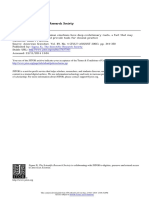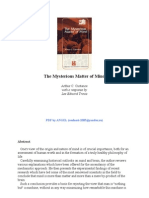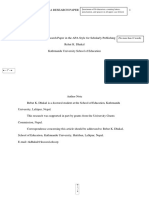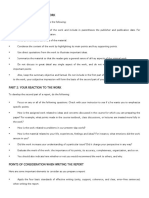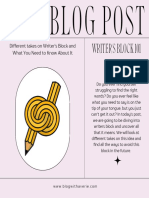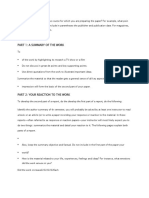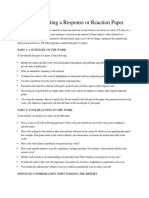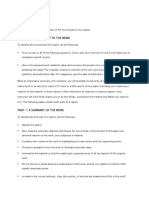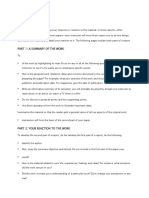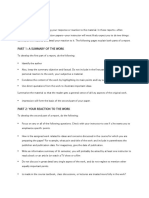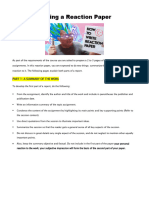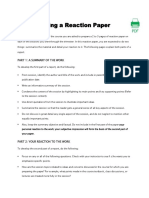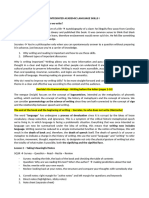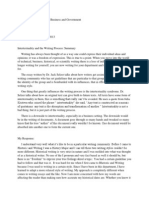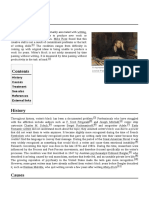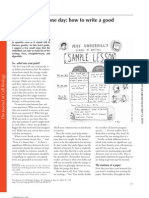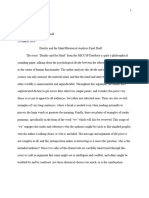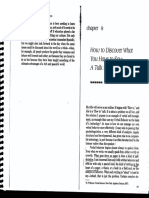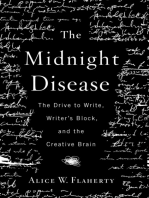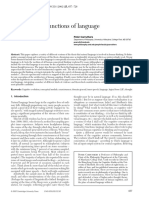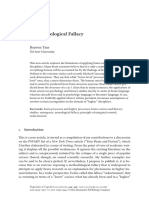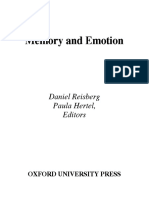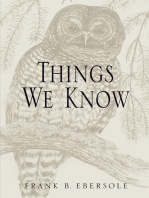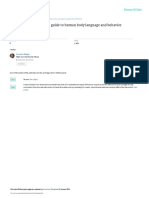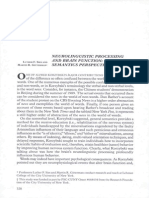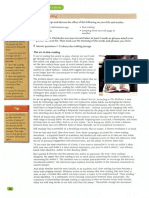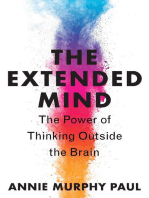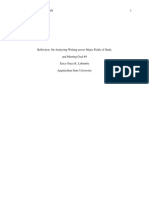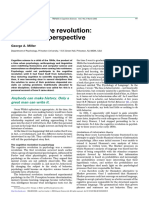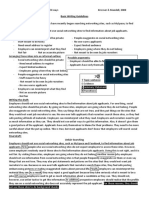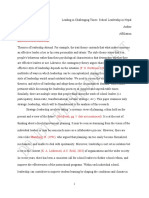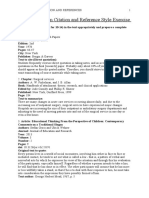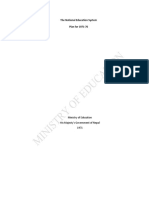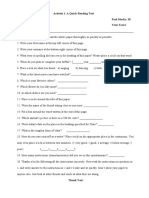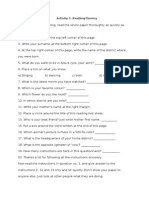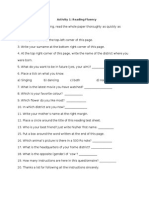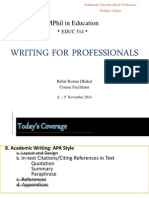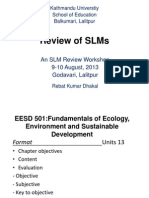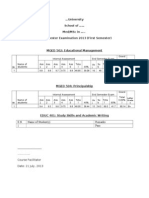0 ratings0% found this document useful (0 votes)
104 viewsWriter's Block
Writer's Block
Uploaded by
Rebat Kumar DhakalThe document discusses writer's block, including its causes, history, and relationship to other conditions. Writer's block can range from mild and temporary to severe and career-ending. It was coined as a term in 1947 and is thought to arise from stress, perfectionism, and procrastination. Other issues like physical impairments, mental illnesses, or substance abuse may also contribute to writer's block. Studies have shown it occurs cross-linguistically and computer use may reduce block for some.
Copyright:
© All Rights Reserved
Available Formats
Download as PDF, TXT or read online from Scribd
Writer's Block
Writer's Block
Uploaded by
Rebat Kumar Dhakal0 ratings0% found this document useful (0 votes)
104 views2 pagesThe document discusses writer's block, including its causes, history, and relationship to other conditions. Writer's block can range from mild and temporary to severe and career-ending. It was coined as a term in 1947 and is thought to arise from stress, perfectionism, and procrastination. Other issues like physical impairments, mental illnesses, or substance abuse may also contribute to writer's block. Studies have shown it occurs cross-linguistically and computer use may reduce block for some.
Original Title
Writer's block
Copyright
© © All Rights Reserved
Available Formats
PDF, TXT or read online from Scribd
Share this document
Did you find this document useful?
Is this content inappropriate?
The document discusses writer's block, including its causes, history, and relationship to other conditions. Writer's block can range from mild and temporary to severe and career-ending. It was coined as a term in 1947 and is thought to arise from stress, perfectionism, and procrastination. Other issues like physical impairments, mental illnesses, or substance abuse may also contribute to writer's block. Studies have shown it occurs cross-linguistically and computer use may reduce block for some.
Copyright:
© All Rights Reserved
Available Formats
Download as PDF, TXT or read online from Scribd
Download as pdf or txt
0 ratings0% found this document useful (0 votes)
104 views2 pagesWriter's Block
Writer's Block
Uploaded by
Rebat Kumar DhakalThe document discusses writer's block, including its causes, history, and relationship to other conditions. Writer's block can range from mild and temporary to severe and career-ending. It was coined as a term in 1947 and is thought to arise from stress, perfectionism, and procrastination. Other issues like physical impairments, mental illnesses, or substance abuse may also contribute to writer's block. Studies have shown it occurs cross-linguistically and computer use may reduce block for some.
Copyright:
© All Rights Reserved
Available Formats
Download as PDF, TXT or read online from Scribd
Download as pdf or txt
You are on page 1of 2
PERSPECTIVES
Writer’s Block In academia, the notion of writer’s block is disdained by younger
members but seems to gain respect at higher levels where it occurs
M. Castillo, Editor-in-Chief more commonly.4
Writer’s block is better termed “creative inhibition” or “cre-
A fter writing nearly 70 Perspectives, it was bound to happen; it
seems I have hit “writer’s block.” This is the first time I sat
down to write my monthly essay in over 8 months and I decided to
ative block.”5 It is becoming more prominent: it was little known
by the early Romantic writers, became more prominent during
the epoch of the French Symbolists, and last, was rampant (and
use the occasion to familiarize myself with this condition (and try became a recognized entity) during the period of the great Amer-
to liberate myself from it). Writer’s block varies in intensity from ican novel. Today, in a manner similar to attention-deficit disor-
extreme (abandoning one’s career as an author—think Harper der, writer’s block is a nearly unique American affliction (though
Lee and Ralph Ellison) to trivial and temporary (which I hope it occasionally happens in other countries, vide infra).6
mine is). Why worry? Most writers have it at one time or another. Agraphia is the ultimate writer’s block because it refers to the
The most common causes cited for writer’s block are lack of in- physiologic inability to write, but, in this case, lesions in the brain,
spiration, illness, depression, financial pressure, and a sense of such as those induced by trauma or stroke, are present and explain
failure. None of these apply to me. In my case, maybe it is just it. Agraphia results from damage to the Wernicke area and is
good old academic pressure. With increasing frequency, I hear nearly always accompanied by other language disabilities. In some
that the only part of AJNR that our subscribers read is my Perspec- cases, the inability to write may be physical, such as so-called
tives, to which I say: What about the rest of the Journal? That is “writer’s cramp.” This is a muscle dystonia, and DTI has shown
where most of my energy and time are spent! And, if our readers fractional anisotropy changes in the fibers connecting the primary
are paying that much attention to my short essays, should each sensorimotor areas with subcortical structures in individuals who
one be better than the last? Writer’s block sounds like the ideal suffer from it.7 In such individuals, fMRI has also shown abnor-
excuse to avoid thinking about what to write (just look at the title mally low activation of the sensorimotor cortex and supplemen-
of my first reference: “Writer’s Block as an Instrument for Re-
tary motor areas.8 The findings of these studies imply that both
maining in Paradise”).1
inhibitory and excitatory mechanisms play a role in writer’s
Writer’s block is a modern notion, and the term was coined in
cramp and that the pain it causes prevents writing by hand. Writ-
1947 by Dr Edmund Bergler, a famous Austrian psychiatrist living
er’s cramp can also develop during typing and other activities
in New York City.2 Today, it is well accepted that the notion of
such as using a screwdriver. Compared with men, women are
writer’s block arose in conjunction with the sudden prestige of
thought to be better writers; however fMRI does not show signif-
psychiatry in the United States after World War II. Dr Bergler, a
icant differences in brain activation for either sex while writing.9
follower of Freud, blamed writer’s block on oral masochism and a
The same study found significant differences between good and
milk-denying mother (that gives me something to think about
poor writers while handwriting, mostly in brain regions involved
because I know that I was bottle-fed!), in addition to other “phal-
with planning for serial finger movements.
lic and anal” explanations along Freudian lines. Stress leads to
The opposite of writer’s block is also known to occur, and it
panic, and some scientists believe that the reticular activating sys-
can be temporary or affect an individual all of his or her life.
tem in the brain stem will shift higher functions associated with
Balzac, Hugo, and Dickens probably had “graphorrhea.” The
writing from the cortex to the limbic system under duress.3 Oth-
problem with calling the obsession to write “graphorrhea” is that
ers disagree and think that the creative writing process starts at the
this term is also used for manic patients who compose long lists,
level of the limbic system, whereas more technical writing is ini-
tially fueled by the frontal cortex. If both were true, all writing many times containing only meaningless words, which is not the
would stop as functions shift from one location to the other. How- same as writing many great novels. As psychiatry evolved from an
ever, writer’s block can be selective, as it is in my case. That is, I analytic discipline to a chemical science, writer’s block came to be
continue to write other articles, chapters, and books, but writing blamed on abnormal brain chemistry. More seriously, writer’s
this specific series of essays is my problem. Writer’s block is com- block can be a manifestation of a dangerous underlying psychiat-
monly seen in college and university students who consistently ric disease such as schizophrenia, obsessive compulsive disorder,
fail to turn in their written assignments. In them, procrastination or substance abuse (think Scott Fitzgerald).
(a behavior specifically called “academic trait procrastination”) is Writer’s block has been assessed in individuals who speak lan-
a major component of writer’s block. Procrastination is learned, guages other than English. Two studies addressed it in Chinese
so education specialists claim that it can be unlearned.1 Perfec- and Spanish native speakers and found that it occurs in those
tionism is also blamed for the block; it seems to motivate some languages as it does in English.10-12 In other languages, as in Eng-
procrastination, and together these both promote writer’s block.1 lish, writer’s block appears to be related to premature editing and
to a lack of strategies for dealing with complex writing tasks. De-
veloping a strategy before the actual writing helps some individ-
http://dx.doi.org/10.3174/ajnr.A3729 uals. Princeton Professor and author John McPhee tells a related
AJNR Am J Neuroradiol 35:1043– 44 Jun 2014 www.ajnr.org 1043
story in his essay “Structure.”13 For 2 weeks he lay down on a fMRI has proved (many times) that ideomotor effects originate in
picnic table under the trees looking at them and wondering how the brain and not outside of it.19
to start a piece on pines. After 8 months of work, he was finally At this point, I must say that having finished this Perspectives,
able to turn it in. He suggests that having a preplanned structure I feel somewhat liberated. Whether that feeling will be short-lived
eases the stress of writing and results in a better organized and or last and allow me to write next month’s piece, you, kind reader,
flowing article. The ease of cutting and pasting makes attaining must wait and see.
the desired structure easier today than in the past.
The use of a computer with word-processing capabilities re- REFERENCES
duces writer’s block for second-language writers but not for na- 1. Smeets S. Writer’s block as an instrument for remaining in para-
tive-language writers.14 Spelling is also intimately related to the dise. Zeitschrift Schreiben 2008 Jun 22 [Epub]
2. http://en.wikipedia.org/wiki/Edmund_Bergler#cite_note-Akhtar2009 –
ability to write. In one study, disabled spellers showed signifi- 11. Accessed July 24, 2013
cantly more activation in clusters of neural networks associated 3. Bane R. The writer’s brain: what neurology tells us about teaching cre-
with working memory and executive functions.15 Computer pro- ative writing. http://www.rosannebane.com/newsletters/The_Writer%
grams that automatically correct spelling may help these individ- 27%27s_Brain.Rosanne_Bane.41–50%5B1%5D.pdf.AccessedJuly24,2013
4. Gumz A, Brahler E, Erices R. Burnout experience and work disrup-
uals overcome writer’s block. tions among clients seeking counseling: an investigation of differ-
Because writing is intimately related to reading, recognition of ent groups of academic level. Psychother Psychosom Med Psychol
the written word is needed for both activities. Alexia is a condition 2012;62:33–39
in which patients lose their ability to read and is associated with 5. Kantor M. Understanding Writer’s Block: A Therapist’s Guide to Diag-
nosis and Treatment. Westport, Connecticut: Praeger; 1995
lesions in the left parietal and occipital lobes.16 Alexia has been
6. Acocella J. Blocked: why do writers stop writing? The New Yorker
“folklorized” in several accounts by the famous and popular au- June 16, 2004
thor and neurologist Oliver Sacks. His patients who had this con- 7. Delmaire C, Vidailhet M, Wassermann D, et al. Diffusion abnormal-
dition were said to have lesions affecting the VWFA (visual word ities in the primary sensorimotor pathways in writer’s cramp. Arch
Neurol 2009;66:502– 08
recognition area), which is presumably located in the left midfusi-
8. Oga T, Honda M, Toma K, et al. Abnormal cortical mechanisms of
form gyrus (running from temporal to occipital lobe under the voluntary muscle relaxation in patients with writer’s cramp: an
parahippocampal gyrus). Because this area is also involved in the fMRI study. Brain 2002;125:895–903
recognition of auditory, phonologic, and visual impulses, patients 9. Richards TL, Berninger VW, Stock P, et al. fMRI sequential-finger
movement activation differentiating good and poor writers. J Clin
with lesions there have more symptoms than alexia only. Pure
Exp Neuropsychol 2009;31:967– 83
alexia caused by a lesion in the VWFA has not been reported. 10. Lee S, Krashen S. Writer’s block in a Chinese sample. Percept Mot
More importantly, a meta-analysis of the literature, including Skills 2003;97:537– 42
fMRI studies, states that this brain region does not participate in 11. Betancourt F, Phinney M. Sources of writing block in bilingual writ-
ers. Written Communications 1990;7:482–511
visual word processing, and thus its concept is erroneous.17 Alexia
12. Phinney M. Word processing and writing apprehension in first and
without agraphia occurs with lesions involving the left-sided sp- second language writers. Computers Composition 1991;9:65– 82
lenium of the corpus callosum. 13. McPhee J. Structure: beyond the picnic-table crisis. The New Yorker
Strategies for coping with (and curing) writer’s block include January 14, 2013, pp 46 –55
group discussions, brainstorming (I wrote an essay against this), 14. Richards TL, Berninger V, Winn W, et al. Differences in fMRI acti-
vation between children with and without spelling disability on
list-making (I have a long list of topics that I have considered, but 2-back/0-back working memory contrast. J Writing Res 2009;
none seem very attractive now), and engaging with the text (I have 1:93–123
no idea what this means). Recalcitrant blockage must be treated 15. Huston P. Resolving writer’s block. Can Fam Physician 1998;
with extensive “therapy.”15 Other cures include “automatic writ- 44:92–97
16. Alexia (condition). http://en.wikipedia.org/wiki/Alexia_(condition).
ing” in which texts are produced from the subconscious without Accessed July 24, 2013
conscious awareness.18 Instead of coming directly from the writ- 17. Price CJ, Devlin JT. The myth of the visual word form area. Neuro-
er’s mind, Arthur Conan Doyle believed that automatic writing Image 2003;19:473– 81
came from external spirits. Channeling writing from a spirit is 18. Automatic writing. http://en.wikipedia.org/wiki/Automatic_writing.
Accessed July 24, 2013
called “psychography.” Both phenomena may be explained as
19. Spengler S, von Cramon DY, Brass M. Was it me or was it you? How
“ideomotor effects” meaning just an activity of which we are par- the sense of agency originates from the ideomotor learning revealed
tially or completely unaware. Of course, all of this is nonsense, and by fMRI. NeuroImage 2009;46:290 –98
1044 Editorials Jun 2014 www.ajnr.org
You might also like
- English: Third Quarter - Week 4 Critiquing A Literary SelectionDocument6 pagesEnglish: Third Quarter - Week 4 Critiquing A Literary SelectionKimi Legson100% (1)
- A Position Paper On Why Academics Stink at WritingDocument2 pagesA Position Paper On Why Academics Stink at WritingKinno Roger Antonio100% (1)
- Plutchik, R. (2001) - The Nature of Emotions. American Scientist, 89 (4), Pp. 344 - 350 PDFDocument8 pagesPlutchik, R. (2001) - The Nature of Emotions. American Scientist, 89 (4), Pp. 344 - 350 PDFZayne CarrickNo ratings yet
- (Ebook) Custance, Arthur, Ph.D. - The Mysterious Matter of Mind (Mind-Brain Problem) Psychology, Neurology) (Christian Library)Document52 pages(Ebook) Custance, Arthur, Ph.D. - The Mysterious Matter of Mind (Mind-Brain Problem) Psychology, Neurology) (Christian Library)Martin Lasič100% (2)
- Imagination and The Meaningful BrainDocument272 pagesImagination and The Meaningful Brainjuanete9100% (2)
- Interchange EFFECTIVE WRITING (Advanced Level)Document11 pagesInterchange EFFECTIVE WRITING (Advanced Level)Rebat Kumar Dhakal0% (1)
- Writing A Research PaperDocument8 pagesWriting A Research PaperRebat Kumar DhakalNo ratings yet
- Writing A Research PaperDocument8 pagesWriting A Research PaperRebat Kumar DhakalNo ratings yet
- Writing A Response or Reaction PaperDocument5 pagesWriting A Response or Reaction PaperMay ArrizaNo ratings yet
- Part 1: A Summary of The WorkDocument4 pagesPart 1: A Summary of The WorkdaryllNo ratings yet
- Part 1: A Summary of The WorkDocument6 pagesPart 1: A Summary of The WorkMarie OcampoNo ratings yet
- Blue Modern New Blog Post Instagram Post 1Document17 pagesBlue Modern New Blog Post Instagram Post 1api-659426340No ratings yet
- Part 1: A Summary of The WorkDocument6 pagesPart 1: A Summary of The WorkEma Dela CruzNo ratings yet
- Part 1: A Summary of The WorkDocument6 pagesPart 1: A Summary of The WorkMarie OcampoNo ratings yet
- Part 1: A Summary of The WorkDocument6 pagesPart 1: A Summary of The WorkMarie OcampoNo ratings yet
- Writing A Reaction PaperDocument5 pagesWriting A Reaction PaperEireced MntgdNo ratings yet
- Part 2: Your Reaction To The WorkDocument6 pagesPart 2: Your Reaction To The WorkMarie OcampoNo ratings yet
- Part 1: A Summary of The WorkDocument6 pagesPart 1: A Summary of The WorkMarie OcampoNo ratings yet
- Part 1: A Summary of The WorkDocument6 pagesPart 1: A Summary of The WorkMarie OcampoNo ratings yet
- Part 1: A Summary of The WorkDocument6 pagesPart 1: A Summary of The WorkMarie OcampoNo ratings yet
- Battle Writers BlockDocument20 pagesBattle Writers BlockFootballBeastNo ratings yet
- Writing A Reaction Paper 1Document7 pagesWriting A Reaction Paper 1Neil VillasNo ratings yet
- Reaction Paper 1Document10 pagesReaction Paper 1Mark Joseph PiliinNo ratings yet
- Part 1: A Summary of The WorkDocument6 pagesPart 1: A Summary of The WorkMarie OcampoNo ratings yet
- Integrated Academic Language SkillsDocument4 pagesIntegrated Academic Language Skillsemma.alberini.2016No ratings yet
- Blog BrainDocument38 pagesBlog BrainjdneuvnhsjshNo ratings yet
- IntertextualityDocument4 pagesIntertextualityapi-245453878No ratings yet
- Volume 30, Issue 8 - of Grim Times & Budget CutsDocument12 pagesVolume 30, Issue 8 - of Grim Times & Budget CutsThe Dartmouth ReviewNo ratings yet
- Quiz 2 WNC Spring 21Document8 pagesQuiz 2 WNC Spring 21Murtaza HayatNo ratings yet
- Writer's Block Is A Condition, Primarily Associated With WritingDocument6 pagesWriter's Block Is A Condition, Primarily Associated With WritingOzhenNo ratings yet
- Writing A Response or Reaction Paper PDFDocument4 pagesWriting A Response or Reaction Paper PDFWilliam Guillermo Galanto CustodioNo ratings yet
- Writing A Response or Reaction Paper PDFDocument4 pagesWriting A Response or Reaction Paper PDFWilliam Guillermo Galanto CustodioNo ratings yet
- MeWritePretty FullDocument2 pagesMeWritePretty Fullrousseaux12No ratings yet
- Eng 125 Rhetorical Analysis Final DraftDocument8 pagesEng 125 Rhetorical Analysis Final Draftapi-742844270No ratings yet
- Elements of Episodic MemoryDocument350 pagesElements of Episodic MemoryRoberson MachadoNo ratings yet
- WP 2 KunianskiDocument10 pagesWP 2 Kunianskiapi-311442046No ratings yet
- Conceptualism & The BodyDocument2 pagesConceptualism & The BodyMatthew LandisNo ratings yet
- SINNER - How To Discover What You Have To Say - Skinner PDFDocument7 pagesSINNER - How To Discover What You Have To Say - Skinner PDFPedroVítorSouzaRodriguesNo ratings yet
- The Midnight Disease: The Drive to Write, Writer's Block, and the Creative BrainFrom EverandThe Midnight Disease: The Drive to Write, Writer's Block, and the Creative BrainRating: 4 out of 5 stars4/5 (74)
- Cognitive Functions of The Language - Carruthers 2002Document69 pagesCognitive Functions of The Language - Carruthers 2002Rafael MartinsNo ratings yet
- Stream of Consciousness in the Modern Novel: A Study of James Joyce, Virginia Woolf, Dorothy Richardson, William Faulkner, and OthersFrom EverandStream of Consciousness in the Modern Novel: A Study of James Joyce, Virginia Woolf, Dorothy Richardson, William Faulkner, and OthersNo ratings yet
- What Is An Emotion A Debate Adolphs and Lisa F Barret 2020Document10 pagesWhat Is An Emotion A Debate Adolphs and Lisa F Barret 2020AshleyNo ratings yet
- The Neurological Fallacy PDFDocument18 pagesThe Neurological Fallacy PDFAlina RoinițăNo ratings yet
- How To Analyze A Quotation Like An English TeacherDocument2 pagesHow To Analyze A Quotation Like An English Teacherjeffherb60% (5)
- Memory and Emotion - Oxford (2003)Document428 pagesMemory and Emotion - Oxford (2003)Gabriel BudianNo ratings yet
- Reader Response Theory PDFDocument3 pagesReader Response Theory PDFShravya ShrutiNo ratings yet
- Things We Know: Fifteen Essays on Problems of Knowledge: Second EditionFrom EverandThings We Know: Fifteen Essays on Problems of Knowledge: Second EditionNo ratings yet
- Literature 1Document51 pagesLiterature 1الفرح ليس مهنتيNo ratings yet
- Against Behaviorism: Thomas SzaszDocument4 pagesAgainst Behaviorism: Thomas SzaszAbdelrahman Abdallah TI from London RIPNo ratings yet
- NUIdeas Kabara 3.1Document5 pagesNUIdeas Kabara 3.1Umer AdnanNo ratings yet
- Aa 1968 70 5 02a00200 PDF JsessionidDocument2 pagesAa 1968 70 5 02a00200 PDF JsessionidضكثمNo ratings yet
- Linguistic Boletin 3Document5 pagesLinguistic Boletin 3Cristy Soledad PAEZ SARAZANo ratings yet
- People Watching: A Novel Guide To Human Body Language and BehaviorDocument4 pagesPeople Watching: A Novel Guide To Human Body Language and BehaviorSakthiNo ratings yet
- Brain TheoryDocument41 pagesBrain TheoryNikhil NigamNo ratings yet
- Metacognitive Reflection For Writing 2 PortfolioDocument6 pagesMetacognitive Reflection For Writing 2 Portfolioapi-658792051No ratings yet
- Neurolinguistic Processing (NLP) and Brain Function: A General Semantics Perspective by Luther F. Sies and Martin R. GittermanDocument7 pagesNeurolinguistic Processing (NLP) and Brain Function: A General Semantics Perspective by Luther F. Sies and Martin R. GittermanMike McDNo ratings yet
- Awk1 SAT ReadingDocument2 pagesAwk1 SAT ReadingMar John Louie BacanayaNo ratings yet
- The Extended Mind: The Power of Thinking Outside the BrainFrom EverandThe Extended Mind: The Power of Thinking Outside the BrainRating: 3.5 out of 5 stars3.5/5 (27)
- ReflectionDocument4 pagesReflectionapi-458342617No ratings yet
- Psicanàlise e PsiquiatriaDocument1 pagePsicanàlise e Psiquiatriaedson miazatoNo ratings yet
- The Cognitive Revolution A Historical Perspective PDFDocument4 pagesThe Cognitive Revolution A Historical Perspective PDFRaNo ratings yet
- Basic Writing GuidelinesDocument3 pagesBasic Writing GuidelinesRebat Kumar DhakalNo ratings yet
- Citation Basics - Class ActivityDocument5 pagesCitation Basics - Class ActivityRebat Kumar DhakalNo ratings yet
- Academic Writing and APA Style: Kathmandu University School of Education Hattiban, LalitpurDocument2 pagesAcademic Writing and APA Style: Kathmandu University School of Education Hattiban, LalitpurRebat Kumar DhakalNo ratings yet
- Exercise-5-APA Citation and ReferencesDocument3 pagesExercise-5-APA Citation and ReferencesRebat Kumar DhakalNo ratings yet
- Course Sign Up Form: Kathmandu University School of Education Hattiban, LalitpurDocument1 pageCourse Sign Up Form: Kathmandu University School of Education Hattiban, LalitpurRebat Kumar DhakalNo ratings yet
- National Education System Plan 2028Document94 pagesNational Education System Plan 2028Rebat Kumar Dhakal100% (2)
- Activity I: A Quick Reading Test EDUC 514 Fool Marks: 20 Date: - Your ScoreDocument1 pageActivity I: A Quick Reading Test EDUC 514 Fool Marks: 20 Date: - Your ScoreRebat Kumar DhakalNo ratings yet
- Compulsory English: Xi The Magic of Words: 6. My Heart Leaps Up When I BeholdDocument14 pagesCompulsory English: Xi The Magic of Words: 6. My Heart Leaps Up When I BeholdRebat Kumar DhakalNo ratings yet
- TERSD Conference: Program and AbstractsDocument2 pagesTERSD Conference: Program and AbstractsRebat Kumar DhakalNo ratings yet
- Day I PrintablesDocument13 pagesDay I PrintablesRebat Kumar DhakalNo ratings yet
- Activity 1: Reading FluencyDocument6 pagesActivity 1: Reading FluencyRebat Kumar DhakalNo ratings yet
- Writing For Professionals: Mphil in EducationDocument32 pagesWriting For Professionals: Mphil in EducationRebat Kumar DhakalNo ratings yet
- Journal of Education and ResearchDocument114 pagesJournal of Education and ResearchRebat Kumar DhakalNo ratings yet
- Join Us If What You Crave For Is To:: Admission Call 2 0 1 4 B A T C HDocument1 pageJoin Us If What You Crave For Is To:: Admission Call 2 0 1 4 B A T C HRebat Kumar DhakalNo ratings yet
- Writing For Professionals: Mphil in EducationDocument32 pagesWriting For Professionals: Mphil in EducationRebat Kumar DhakalNo ratings yet
- Curriculum Review Workshop - RKDDocument6 pagesCurriculum Review Workshop - RKDRebat Kumar DhakalNo ratings yet
- De Result Sheet SampleDocument1 pageDe Result Sheet SampleRebat Kumar DhakalNo ratings yet
- Admin Login: Vehicle Parking ManagementDocument27 pagesAdmin Login: Vehicle Parking ManagementRajesh GrNo ratings yet
- Brooklyn de Colm ToibinDocument32 pagesBrooklyn de Colm ToibinphycocatmeowNo ratings yet
- FEM For Rectangular TankDocument6 pagesFEM For Rectangular TankMohamad ArrajNo ratings yet
- Dhaka International University: TH NDDocument2 pagesDhaka International University: TH NDKHAN BIJOYNo ratings yet
- Database AdministrationDocument12 pagesDatabase AdministrationjayNo ratings yet
- Pretext TimeDocument18 pagesPretext Timevisio2010No ratings yet
- Python Summary of Functions and LoopsDocument6 pagesPython Summary of Functions and LoopsheforgiveoursinsNo ratings yet
- Unit 5: GrammarDocument28 pagesUnit 5: GrammarDRISS BAOUCHENo ratings yet
- Men Who Played Important Roles QuestionsDocument2 pagesMen Who Played Important Roles QuestionsPrincess Jovie BitangaNo ratings yet
- MMW Notes PrelimDocument17 pagesMMW Notes PrelimTrixy AlmendraNo ratings yet
- BASIC 8 - Module 5Document3 pagesBASIC 8 - Module 5claypajueloNo ratings yet
- Network Programming PDFDocument351 pagesNetwork Programming PDFBnod Msra100% (1)
- Unit VII Cognition 36Document34 pagesUnit VII Cognition 36朱颖No ratings yet
- Major Periods in English and American LiteratureDocument8 pagesMajor Periods in English and American LiteratureAlexis ViernesNo ratings yet
- Detection of Fake and Clone Accounts in Twitter Using Classification and Distance Measure AlgorithmsDocument6 pagesDetection of Fake and Clone Accounts in Twitter Using Classification and Distance Measure AlgorithmsNiranjan CherukuNo ratings yet
- A Wrong Man in Workers ParadiseDocument2 pagesA Wrong Man in Workers ParadiseParu Maru56% (9)
- Discovering Computers Fundamentals, 2011 Edition: Living in A Digital WorldDocument35 pagesDiscovering Computers Fundamentals, 2011 Edition: Living in A Digital WorldPei Xin ChongNo ratings yet
- What Is Children's LiteratureDocument10 pagesWhat Is Children's LiteratureAttenuator James100% (1)
- Reading and WritingDocument38 pagesReading and WritingKc BaroNo ratings yet
- Industrial Revolution Inventions RubricDocument1 pageIndustrial Revolution Inventions Rubricseb422No ratings yet
- A2 Studentbook Unit 6Document6 pagesA2 Studentbook Unit 6paultrasoliniNo ratings yet
- Group 7 (EAPP)Document40 pagesGroup 7 (EAPP)Cath DetoperezNo ratings yet
- Communication and Its Role in SocietyDocument2 pagesCommunication and Its Role in Societyraditya172No ratings yet
- PHASE 5 Elementary Instructional Continuity Plan GRADE 2Document21 pagesPHASE 5 Elementary Instructional Continuity Plan GRADE 2Isabel Morales SantosNo ratings yet
- What Is BigdataDocument5 pagesWhat Is BigdatavaddeseetharamaiahNo ratings yet
- Literature Review - Jazz ChantsDocument4 pagesLiterature Review - Jazz ChantsEenav EenavNo ratings yet
- COT Q1 - Math 6Document6 pagesCOT Q1 - Math 6Armelou Magsipoc100% (1)
- Konjungsi AsliDocument9 pagesKonjungsi AsliAjeng RidaNo ratings yet
- Ekushe Ain ( ) (Sukumar Ray)Document1 pageEkushe Ain ( ) (Sukumar Ray)Developer FardinNo ratings yet
- Salient Themes in African Poetry: A Re-Appraisal of Library and Information Utilization Process For New MediaDocument11 pagesSalient Themes in African Poetry: A Re-Appraisal of Library and Information Utilization Process For New MediaSONANo ratings yet


